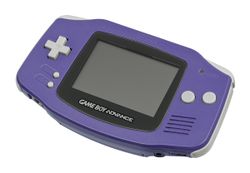Difference between revisions of "Game Boy Advance"
m (Scureuil moved page Gameboy Advance to Game Boy Advance) |
|
(No difference)
| |
Revision as of 22:15, 15 January 2019
|
| |
 The indigo version of the Game Boy Advance. | |
| Manufacturer | Nintendo |
|---|---|
| Product family | Game Boy line |
| Type | Handheld game console |
| Generation | Sixth generation |
| Release date |
JP: March 21, 2001 NA: June 11, 2001 EU: June 22, 2001 |
| Retail availability | 2001–2010 |
| Discontinued | May 15, 2010 |
| Units sold | 81.51 million (2010-6-30) |
| Media | ROM cartridge |
| CPU | ARM7TDMI @ 16.78 MHz, Zilog Z80 @ 8 or 4 MHz |
| Memory | 32 KB internal, 256 KB external, 96 KB VRAM |
| Display | TFT LCD, 240×160 pixels, 40.8×61.2 mm |
| Power | 2 × AA batteries |
| Best-selling game | Pokémon Ruby and Sapphire, 16 million combined |
| Backward compatibility | Game Boy, Game Boy Color |
| Predecessor | Game Boy Color |
| Successor | Nintendo DS |
Introduction
The Game Boy AdvanceTemplate:Efn (GBA) is a 32-bit handheld video game console developed, manufactured and marketed by Nintendo as the successor to the Game Boy Color. It was released in Japan on March 21, 2001, in North America on June 11, 2001, in Australia and Europe on June 22, 2001, and in mainland China on June 8, 2004 as iQue Game Boy Advance. Nintendo's competitors in the handheld market at the time were the Neo Geo Pocket Color, WonderSwan, GP32, Tapwave Zodiac, and the N-Gage. Despite the competitors' best efforts, Nintendo maintained a majority market share with the Game Boy Advance.
As of June 30, 2010, the Game Boy Advance series has sold 81.51 million units worldwide. Its successor, the Nintendo DS, was released in November 2004 and is also compatible with Game Boy Advance software.
Specifications
The technical specifications of the original Game Boy Advance are, as provided by Nintendo:
| Size: | approximately 14.45 cm (5.69 in) x 2.45 cm (0.96 in) x 8.2 cm (3.2 in) (LxWxH), 140 g (4.9 oz). |
|---|---|
| Screen: | 2.9 inches reflective thin-film transistor (TFT) color LCD. |
| Power: | 2× AA batteries |
| Battery life: | approximately 15 hours on average while playing Game Boy Advance games (also dependent on the Game Pak being played, volume setting and any external peripherals being used - e.g. a screen light) |
| CPU: | 16.8 MHz 32-bit ARM7TDMI with embedded memory. 8.4 or 4.2 MHz Sharp LR35902 (8080-derived)
coprocessor for Game Boy backward compatibility. |
| Memory: | 32 kilobyte + 96 kilobyte VRAM (internal to the CPU), 256 kilobyte DRAM (outside the CPU). |
| Resolution: | 240 × 160 pixels (3:2 aspect ratio). |
| Color support: | 15-bit BGR (5 bits depth per channel), capable of displaying 512 simultaneous colors in "character mode" and 32,768 (215) simultaneous colors in "bitmap mode". |
| Sound: | Dual 8-bit DAC for stereo sound (called Direct Sound), plus all legacy channels from Game Boy. The new DACs can be used to play back streams of wave data, or can be used to output multiple wave samples processed/mixed in software by the CPU. |
Backward compatibility for Game Boy and Game Boy Color games is provided by a custom 4.194/8.388 MHz Z80-based coprocessor (Game Boy Advance software can use the audio tone generators to supplement the primary sound system), while a link port at the top of the unit allows it to be connected to other devices using a Game Link cable or GameCube link cable. When playing Game Boy or Game Boy Color games on the Game Boy Advance, the L and R buttons can be used to toggle between a stretched widescreen format (240×144 pixels) and the original screen ratio of the Game Boy (160×144 pixels). Game Boy games can be played using the same selectable color palettes as on the Game Boy Color. Every Nintendo handheld system following the release of the Game Boy Advance SP has included a built-in light and rechargeable battery.
The Game Boy Advance and Nintendo DS 2D graphics hardware have scaling and rotation for traditional tiled backgrounds in its modes 1 and 2 and scaling and rotation for bitmaps in modes 3 through 5 (used less often on the GBA because of technical limitations). On each machine supporting this effect, it is possible to change the scaling and rotation values during the horizontal blanking period of each scanline to draw a flat plane in a perspective projection. More complex effects such as fuzz are possible by using other equations for the position, scaling, and rotation of each line. The "character mode" supports up to 4 tile map background layers per frame, with each tile being 8x8 pixels in size and having 16 or 256 colors. The "character mode" also supports up to 128 hardware sprites per frame, with any sprite size from 8x8 to 64x64 pixels and with 16 or 256 colors per sprite.
Hardware Modification
Case
Tutorial by The Games Shed:
Back-Lit Screen
Tutorial by The Games Shed: